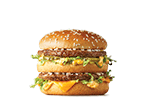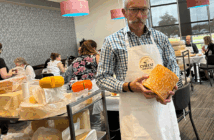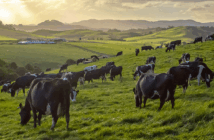
The bakery sits, unassuming, across from a Bunnings Warehouse. From the road there’s little clue as to what goes on behind the walls.
It’s hard to imagine that this is where all New Zealand’s McDonald’s buns, bagels and McMuffins start their journey – from factory to the hands of a hungry diner.
Inside, an experienced team oversee the production of 100 million buns and muffins for McDonalds per year. That’s enough for 20 buns for every New Zealander.
So, what exactly goes into supplying one of the biggest fast food restaurant chains in the world? NZ Food Technology News went inside to find out.
General manager of New Zealand’s Aryzta branch, Colin Petrie, reckons he’s overseen the production of more than a billion McDonald’s buns during his time with the company.
You could say he knows them inside out.
But making buns that stack up to McDonald’s global specifications doesn’t just happen by accident. Each bun, bagel and muffin begins with a set recipe to ensure everything from the flavour, appearance, mouth feel, and size is consistent with McDonald’s restaurants world over.
“Globally they always say it doesn’t matter where you go [McDonald’s] should be damn near the same,” says Colin.
It all begins with special flour sourced from Mauri NZ based in Ōtāhuhu.
“They import the wheat and mill the flour for us based on our specifications. The wheat comes from Australia to ensure the strength and high-quality we need. We run through about 6,000 tonnes of wheat per year.’’
The flour is similar to that which a home baker would use but with higher protein content.
“We like stronger flour because it allows us to develop a nice tight crumb structure that helps retain softness,” he says.
The fresh yeast comes from Hamilton and is supplied by leading baking ingredient supplier Mauri NZ, along with the sugar and improvers added to retain the quality of the bun and keep it fresh.
The buns are made using the sponge dough technique. This means the basic ingredients are added first and then left to ferment for four hours in a special humidity room.
Many New Zealand bakeries use the Mechanical Dough Development method which is popular in English and European bakeries. As McDonald’s was founded in America, most suppliers use the Sponge Dough technique which is the American style.
Once the dough has matured, the remaining ingredients are added, before being divided, put into trays, proved and then baked. Throughout this time the buns pass through several pieces of quality assurance technology.
One such machine looks for any high contrast differences which could indicate inconsistencies. If there is an issue, the machine will blast the dough with a jet of air to deflate it so it shows up as damaged and can be removed from the production line.
Before the buns are baked, they also pass through the sesame seeder and the glazing machine.
Finally, a number of baked buns go through an offline Eye-pro Inspection system to measure the colour, height and weight. The buns are then sliced, packaged and transported.
Due to logistics, most North Island McDonald’s restaurants get their buns delivered fresh, whereas South Island restaurants receive buns frozen to be thawed prior to being used.
McDonald’s spokesperson Simon Kenny says the recipes change from time to time to reflect consumer demand and feedback however, as a company, McDonald’s does not usually make dramatic changes to the old favourites.
“About a decade ago, we did quite a big sugar reduction and we worked with suppliers like Aryzta to make those changes,” he says.
“To be an assured supplier for McDonald’s you have to pass a really high threshold to first become a supplier to McDonald’s. Then you are audited multiple times each year to make sure you are meeting our specifications both in food safety, health and safety, people practice and the sustainability of the supply chain.”
McDonald’s trace everything that goes into making their products – where the flour is sourced from, the sesame seeds and even the packaging.
“We need to know that packaging fibre is sourced from sustainable farms. It is not just our suppliers who need to meet our specifications, it’s suppliers to our suppliers.”
Some keen McDonald’s enthusiasts may have noticed a slight change to the Big Mac bun last year.
“The biggest recipe change came to New Zealand and Australia about the same time last year. They decided to update the way the buns were made and how they were toasted to give a hotter more toasted bun,” Simon says.
“The Big Mac you eat today versus one from 20 years ago would be quite different. The overall amount of bun would be the same, but the bun got smaller in diameter and taller.
“They were working out the ratio of bun to beef to cheese to sauce. The glaze on the top of the Big Mac bun is darker as well. That means then when it’s toasted it has a better mouth feel and an improved taste test. They also lengthened the toast time.
“Every second counts when you are at the drive-thru so we are always balancing how fast we can make a burger versus the overall quality of the product.”




























































































